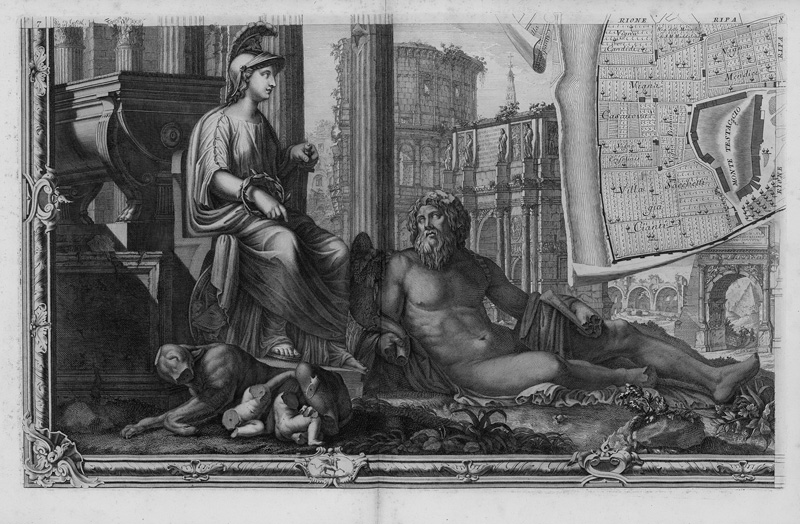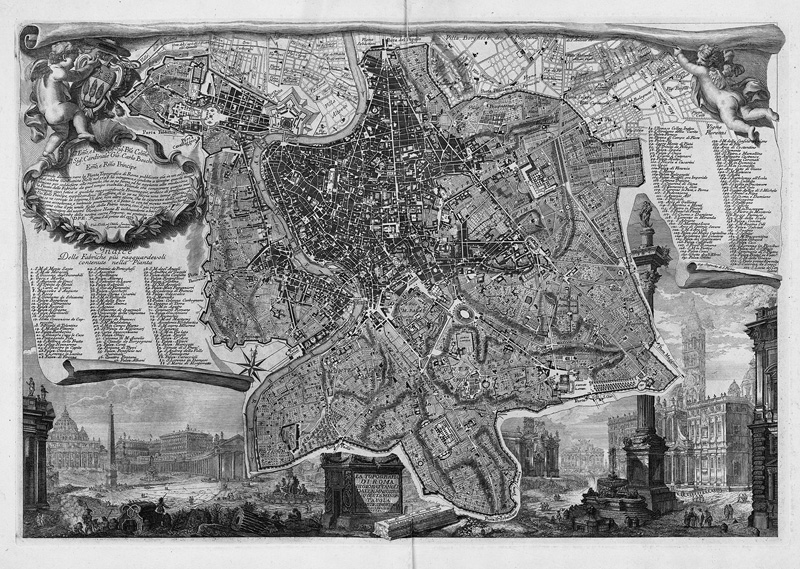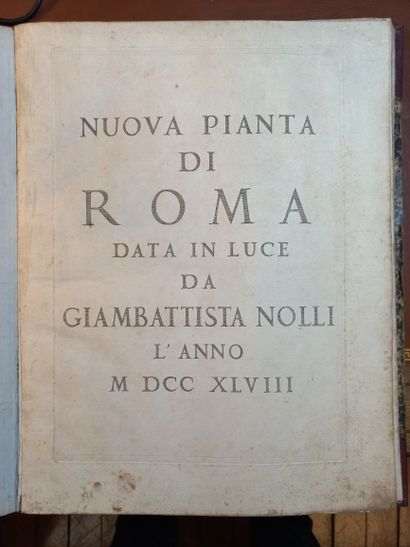NOLLI, Giovanni Battista (c.1692-1756). [ Nuova Pianta di Roma .] Rome: 1748. The finest of the eighteenth-century plans of Rome and the first plan of the city based upon geodetic principles. With Rocque's plan of London and Bretez's plan of Paris, Nolli's plan ranks as one of the greatest eighteenth-century plans of any European city. Rome appears in its essentially Renaissance form with large areas within the ancient walls still occupied by villas with extensive fields, orchards and gardens. The Coliseum, for example, still stands in virtually open country. Many important ancient sites, such as the Circus Maximus and the Forum, are shown in an unearthed state. The lower sheets are almost entirely taken up by lavish, finely engraved ornamentation in the style of Piranesi. In the lower left corner is a montage of classical landmarks, including the Coliseum, Arch of Constantine, Forum, and Trajan's Column, before which are allegorical figures including Romulus and Remus in the form of broken ancient statuary. The lower right corner contains an allegorical representation of the Church seated before Michelangelo's assemblage of buildings on the Capitoline Hill. The plates for the assembled map were originally issued in book form, with title and index leaves, not present here. Frutaz CLXIXa. Engraved wall map of Rome, 24 joined segments mounted on linen, overall image size 1708 x 2061mm on 1740 x 2065mm sheet (scattered few tiny ink stains, some segments with very pale toning, laid down on linen). The vignettes of allegorical figures are after Stefano Pozzi
NOLLI, Giovanni Battista (c.1692-1756). [ Nuova Pianta di Roma .] Rome: 1748. The finest of the eighteenth-century plans of Rome and the first plan of the city based upon geodetic principles. With Rocque's plan of London and Bretez's plan of Paris, Nolli's plan ranks as one of the greatest eighteenth-century plans of any European city. Rome appears in its essentially Renaissance form with large areas within the ancient walls still occupied by villas with extensive fields, orchards and gardens. The Coliseum, for example, still stands in virtually open country. Many important ancient sites, such as the Circus Maximus and the Forum, are shown in an unearthed state. The lower sheets are almost entirely taken up by lavish, finely engraved ornamentation in the style of Piranesi. In the lower left corner is a montage of classical landmarks, including the Coliseum, Arch of Constantine, Forum, and Trajan's Column, before which are allegorical figures including Romulus and Remus in the form of broken ancient statuary. The lower right corner contains an allegorical representation of the Church seated before Michelangelo's assemblage of buildings on the Capitoline Hill. The plates for the assembled map were originally issued in book form, with title and index leaves, not present here. Frutaz CLXIXa. Engraved wall map of Rome, 24 joined segments mounted on linen, overall image size 1708 x 2061mm on 1740 x 2065mm sheet (scattered few tiny ink stains, some segments with very pale toning, laid down on linen). The vignettes of allegorical figures are after Stefano Pozzi















Testen Sie LotSearch und seine Premium-Features 7 Tage - ohne Kosten!
Lassen Sie sich automatisch über neue Objekte in kommenden Auktionen benachrichtigen.
Suchauftrag anlegen